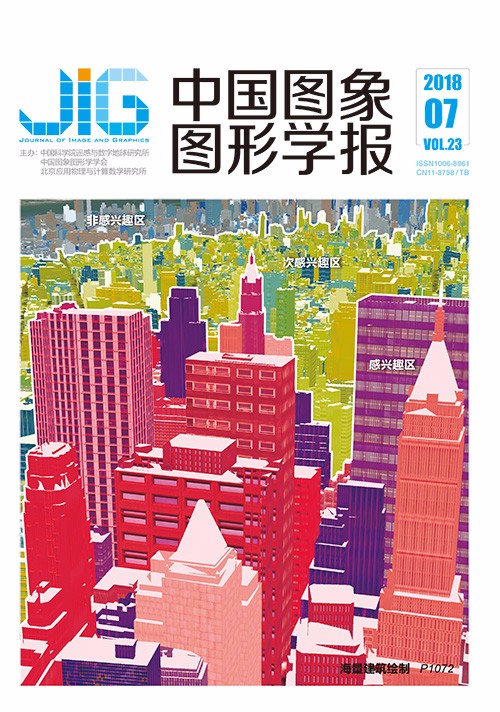
混合特性正则化约束的运动模糊盲复原
摘 要
目的 为了提高运动模糊图像盲复原清晰度,提出一种混合特性正则化约束的运动模糊盲复原算法。方法 首先利用基于局部加权全变差的结构提取算法提取显著边缘,降低了噪声对边缘提取的影响。然后改进模糊核模型的平滑与保真正则项,在保证精确估计的同时,增强了模糊核的抗噪性能。最后改进梯度拟合策略,并加入保边正则项,使图像梯度更加符合重尾分布特性,且保证了边缘细节。结果 本文通过两组实验验证改进模型与所提算法的优越性。实验1以模拟运动模糊图像作为实验对象,通过对比分析5种组合步骤算法的复原效果,验证了本文改进模糊核模型与改进复原图像模型的鲁棒性较强。实验结果表明,本文改进模型复原图像的边缘细节更加清晰自然,评价指标明显提升。实验2以小型无人机真实运动模糊图像为实验对象,通过与传统算法进行对比,对比分析了所提算法的鲁棒性与实用性。实验结果表明,本文算法复原图像的标准差提升约11.4%,平均梯度提升约30.1%,信息熵提升约2.2%,且具有较好的主观视觉效果。结论 针对运动模糊图像盲复原,通过理论分析和实验验证,说明了本文改进模型的优越性,所提算法的复原效果较好。
关键词
Mixed-feature regularization constraint for motion blur blind restoration
Li Zhe1, Li Jianzeng1, Zhang Yan1, Wang Zhe2(1.Department of UAV engineering, Army Engineering University, Shijiazhuang 050003, China;2.College of Materials Science and Engineering, Chongqing University, Chongqing 400030, China) Abstract
Objective Motion blur blind restoration is the process of restoring a clear image without knowledge of the motion blur kernel function of the image. Resolving the fuzzy kernel and the clear image accurately and efficiently is the key to blind restoration. The regularization constraint technique approximates the reconstructed image to the ideal image by properly adding regular items with prior knowledge in the model. The blind restoration problem can be solved quickly and effectively using this technique. Unlike the single regularization method, the hybrid property regularization method can use known multiple prior conditions to impose numerous constraints on the model. While improving the accuracy of model solving, the number of iterations is reduced. Therefore, the multiple mixed feature regularization constraint method for the motion blur blind restoration method should be studied. To address the problems of poor anti-noise performance, incomplete fuzzy kernel smoothness constraint, and edge blurring of restored images in existing methods, a mixed feature regularization constraint method for the motion blur blind restoration method is proposed.Method First, to improve the accuracy of the estimated fuzzy kernel model, the edge of the image is extracted to act on the fidelity term and thus estimate the fuzzy kernel. Edge extraction is easily disturbed by noise, thereby leading to the generation of false edges or additional noise and consequently reducing the estimation accuracy of the fuzzy kernel model. Therefore, the Local weighted total variation structure extraction algorithm is used to detect the significant edges of the blurred image to improve the anti-noise performance of the fuzzy kernel model. Then, sparse regular items and improved smooth regular items are added in this work to improve the sparsity and smoothness of the fuzzy kernel. L0 norm smoothness regularization is complicated; thus, the L1 norm of the fuzzy kernel is used to achieve the sparse constraint. An improved multiple mixed regularization term is used to achieve the smoothing restraint while further suppressing the outlier value due to the insignificant suppression effect of the Tikhonov regularization term outlier value. Finally, for the restored image to have a heavy-tailed character and to enhance the sharpness of the edge of the restored image, the super Laplacian prior and edge-preserving regularization terms are added in this work. The Laplacian prior is used to fit the gradient distribution of the clear image to enrich the edge details due to the poor fitting effect of other prior distributions. The edge resolution of the restored image is poor because only the heavy-tailed property constraint is used on the restored image model. Therefore, edge preserving regularization items are added to make the edge of the restored image close to the sharpened edge of the clear image.Result In this study, the advantages of the improved model and the proposed algorithm are verified by two groups of experiments. In the first experiment, the simulated motion blur image is taken as the experimental object. A comparison and an analysis of the restoration effects of the five combined steps verifies the robustness of the improved fuzzy kernel model and the improved restored image model. Experimental results show that the edge details of the improved model restoration image in this work are clear and natural and the evaluation index is noticeably improved. In the second experiment, the real motion blur image of a small UAV is used as the experimental object. The robustness and practicability of the proposed algorithm are analyzed. Moreover, the proposed algorithm is compared with the traditional algorithm. Experimental results show that the standard deviation of the restored image increases by approximately 11.4%. The average gradient increases by approximately 30.1%. The information entropy increases by approximately 2.2%. Furthermore, our method has better subjective visual effects than the traditional method has.Conclusion For the blind restoration of motion blur images, the superiority of the improved model proposed in this work is demonstrated through theoretical analysis and experimental verification. Restoration through the proposed algorithm is better than that with the traditional algorithm.
Keywords
blind image restoration motion blur mixed feature regularization constraint edge detection blur kernel
|



 中国图象图形学报 │ 京ICP备05080539号-4 │ 本系统由
中国图象图形学报 │ 京ICP备05080539号-4 │ 本系统由